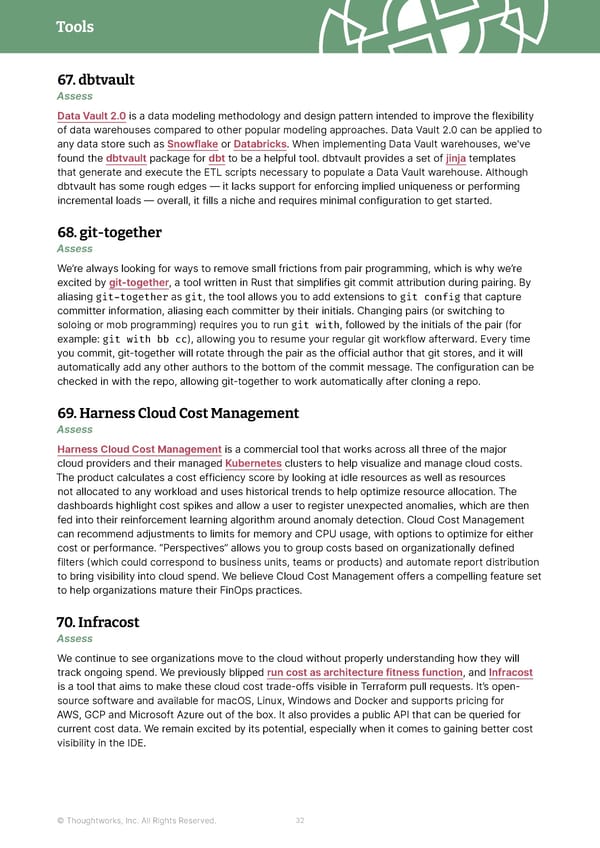Tools Thoughtworks Technology Radar 67. dbtvault Assess Data Vault 2.0 is a data modeling methodology and design pattern intended to improve the flexibility of data warehouses compared to other popular modeling approaches. Data Vault 2.0 can be applied to any data store such as Snowflake or Databricks. When implementing Data Vault warehouses, we’ve found the dbtvault package for dbt to be a helpful tool. dbtvault provides a set of jinja templates that generate and execute the ETL scripts necessary to populate a Data Vault warehouse. Although dbtvault has some rough edges — it lacks support for enforcing implied uniqueness or performing incremental loads — overall, it fills a niche and requires minimal configuration to get started. 68. git-together Assess We’re always looking for ways to remove small frictions from pair programming, which is why we’re excited by git-together, a tool written in Rust that simplifies git commit attribution during pairing. By aliasing git-together as git, the tool allows you to add extensions to git config that capture committer information, aliasing each committer by their initials. Changing pairs (or switching to soloing or mob programming) requires you to run git with, followed by the initials of the pair (for example: git with bb cc), allowing you to resume your regular git workflow afterward. Every time you commit, git-together will rotate through the pair as the official author that git stores, and it will automatically add any other authors to the bottom of the commit message. The configuration can be checked in with the repo, allowing git-together to work automatically after cloning a repo. 69. Harness Cloud Cost Management Assess Harness Cloud Cost Management is a commercial tool that works across all three of the major cloud providers and their managed Kubernetes clusters to help visualize and manage cloud costs. The product calculates a cost efficiency score by looking at idle resources as well as resources not allocated to any workload and uses historical trends to help optimize resource allocation. The dashboards highlight cost spikes and allow a user to register unexpected anomalies, which are then fed into their reinforcement learning algorithm around anomaly detection. Cloud Cost Management can recommend adjustments to limits for memory and CPU usage, with options to optimize for either cost or performance. “Perspectives” allows you to group costs based on organizationally defined filters (which could correspond to business units, teams or products) and automate report distribution to bring visibility into cloud spend. We believe Cloud Cost Management offers a compelling feature set to help organizations mature their FinOps practices. 70. Infracost Assess We continue to see organizations move to the cloud without properly understanding how they will track ongoing spend. We previously blipped run cost as architecture fitness function, and Infracost is a tool that aims to make these cloud cost trade-offs visible in Terraform pull requests. It’s open- source software and available for macOS, Linux, Windows and Docker and supports pricing for AWS, GCP and Microsoft Azure out of the box. It also provides a public API that can be queried for current cost data. We remain excited by its potential, especially when it comes to gaining better cost visibility in the IDE. © Thoughtworks, Inc. All Rights Reserved. 32
 Vol 27 | Technology Radar Page 31 Page 33
Vol 27 | Technology Radar Page 31 Page 33